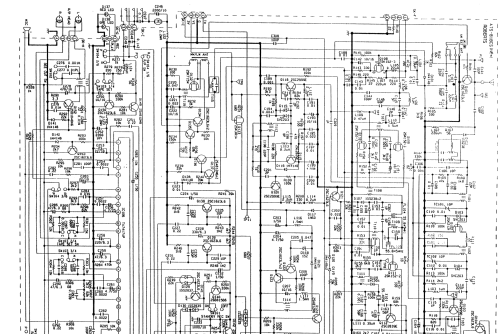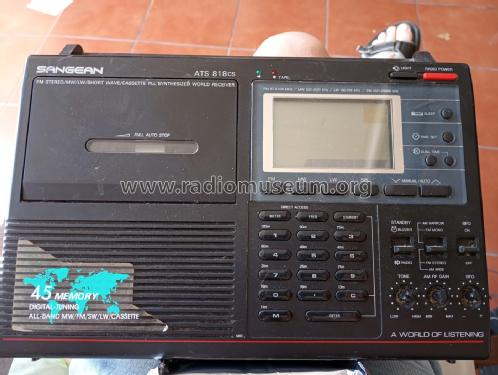ATS-818CS
Sangean; Chung Ho City
- Hersteller / Marke
- Sangean; Chung Ho City
- Jahr
- 1992 ?
- Kategorie
- Rundfunkempfänger (Radio - oder Tuner nach WW2)
- Radiomuseum.org ID
- 78113
Klicken Sie auf den Schaltplanausschnitt, um diesen kostenlos als Dokument anzufordern.
- Anzahl Transistoren
- Halbleiter vorhanden.
- Halbleiter
- Hauptprinzip
- Super mit Mehrfachmischung; ZF/IF 49995/450 kHz
- Wellenbereiche
- Langwelle, Mittelwelle, mehrere Kurzwellenbänder plus UKW (FM).
- Spezialitäten
- Kassetten-Recorder oder -Spieler
- Betriebsart / Volt
- Trockenbatterien / 4 x 1,5 Volt
- Lautsprecher
- Dynamischer LS, keine Erregerspule (permanentdynamisch)
- Material
- Plastikgehäuse (nicht Bakelit), Thermoplast
- von Radiomuseum.org
- Modell: ATS-818CS - Sangean; Chung Ho City
- Form
- Reisegerät > 20 cm (netzunabhängig betreibbar)
- Abmessungen (BHT)
- 300 x 190 x 70 mm / 11.8 x 7.5 x 2.8 inch
- Bemerkung
-
AM coverage 150 - 29999 kHz; AM, SSB(BFO); direct keypad frequency entry, 45 memories, clock/timer;
Also sold as Siemens RK-670, Radio Shack Realistic DX-392 and Roberts RC818.From the European Service Manual for the Sangean ATS-818CS
Wavebands
LW: 150 - 519 kHz
MW: 520 - 1620 / 1710 kHz
SW: 1.621 / 1.711 - 29.999 MHz divided into 13 shortwave ranges. BFO for CW or SSB.
FM:87.5 - 108 MHz, 10.7 MHz IF.AM Wide 6 kHz, AM Narrow 4.5 kHz (6 dB BW, nominal)
Autoscan on AM and FM
FM Stereo on headphone socket, built in 76 kHz PLL MPX decoder and stereo indicator.
Tuning indicator.
Keyboard for direct frequency input with 45 station memories.
Clock with various switching and alarm functions.
Connections
3.5 mm stereo headphones
External 6 V DC (nominal)
AM aerial and earth.
The integrated cassette drive has AC bias for recording and is stereo recording on FM and stereo playback on the earphone socket, 40dB channel separation.Minimum reliable operation is about 4V, +/- 0.2V.
From the User Guide for the Sangean ATS-818CS
The SW band has a second set of nine memories by using 0 as a prefix.
The Standby mode is cancelled by holding C and Standby.
Other comments
- The erase appears to be a magnet, which reduces the dynamic range of recordings to about half.
- The case on some versions may have a small hole in the speaker grill to access the motor speed control otherwise, contrary to the sevice manual you need to remove the main PCB and the cassette deck to adjust the speed, using an external 4.5V to 5V PSU to simulate the typical battery level.
- The ATS-818 has a larger speaker as it's not constrained by the cassette deck.
- The main difference of the ATS-818ACS (badged as Roberts RC828)appears to be extra memories, 54 rather than 45, and the silver effect finish.
- The BFO on/off is separate to memory, so if using BFO on the Amateur bands and you select any MW, SW, LW memory you get a whistle till you turn off the BFO!
- If Standby can't be cancelled: Remove one or more main cells and one AA cpu cell. Count to 20 after the time has completely faded. This resets the CPU.
- The S meter displays the battery status for a few seconds after power off.
- The 1720/1721 split rather than 1620 / 1621 split for MW (Broadcast) and SW may only be USA models.
- AM is dual conversion, may be 49.995MHz and 455 kHz, or 55.845 MHz and 450 kHz. The VHF-FM is 10.7 MHz only
- The Manual mentions a Stereo indicator: There isn't any obvious indication, though the AM Wide / Narrow bandwitch switch enables and disables the stereo decoder.
- Nettogewicht
- 2 kg / 4 lb 6.5 oz (4.405 lb)
- Originalpreis
- 220.00 $
- Autor
- Modellseite von Martin Bösch angelegt. Siehe bei "Änderungsvorschlag" für weitere Mitarbeit.
- Weitere Modelle
-
Hier finden Sie 77 Modelle, davon 76 mit Bildern und 31 mit Schaltbildern.
Alle gelisteten Radios usw. von Sangean; Chung Ho City
Sammlungen
Das Modell befindet sich in den Sammlungen folgender Mitglieder.








